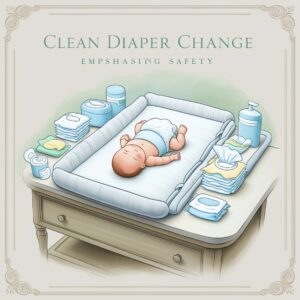Diapering is one of those essential skills every parent has to get right. After all, it is not just a matter of hygiene but also of comfort and preventing some very common problems such as rashes, irritation, or leakages. We’re covering all the expert tips and practical solutions that will make diapering a piece of cake-whether you are a new parent or just need a refresher course. How to pick just the right products, how to master the sustainable options-we have it all covered.
1. Choosing the Right Diaper: Disposable vs. Cloth
Diapers aren’t one-size-fits-all-literally and figuratively. Understanding your options helps ensure your baby’s comfort and health.

- Disposable Diapers: These are convenient, very absorbent, and often come with wetness indicators. However, they may contain chemicals that can irritate sensitive skin, so it is best to use hypoallergenic brands.
- Cloth Diapers: Reusable and environment-friendly, these diapers are the perfect choice for environmentally conscious parents. Sure, they are somewhat more difficult to learn how to work with, but generally speaking, they are soft on your baby’s skin.
- Things to Consider:
– Size: Too tight, and it may irritate the skin; too loose, and you risk leaks.
– Material: Look for breathable, hypoallergenic fabrics.
– Cost: Cloth diapers save money long-term, while disposable ones are pricier but more convenient.
2. Mastering Diaper Changing Techniques
A smooth diaper-changing routine not only keeps your baby clean but also strengthens your bond.

Prep Your Changing Area:
- Gather essentials: diapers, wipes, creams, and a clean surface.
- Change your baby on a stable changing table or mat with raised sides to prevent falls.
Steps to a Clean Change:
- Don’t slip up. Remove the dirty diaper carefully to avoid spills.
- Clean your baby’s bottom with fragrance-free wipes or warm water and cotton pads. To avoid infection, always wipe from front to back.
- Let the area air dry for a few seconds before applying rash cream or powder.
- Securely yet loosely fasten the fresh diaper.
Safety First:
- When changing your baby’s diaper, never leave them unsupervised.
- Keep small items, like pins or creams, out of reach.
3. Prevention and Treatment of Diaper Rash
Diaper rash is one of the most prevalent problems that parents need to face; yet, with good care, it is largely avoidable.

- Causes: Extended periods in dampness, the action of friction, or irritating elements in wipes or diapers.
- Prevention Tips:
– Changes should be effected frequently, every 2–3 hours, or at once if wet/soiled.
– Covers for breathing diapers will lower the warmth and moisture accumulation.
– Apply barrier creams containing zinc oxide. - Home Care:
– Coconut oil: Natural moisturizer that does not have side effects and also has antimicrobial action.
– Oatmeal bath: Relieves irritation of the skin. The colloidal oatmeal is added to the bath water.
– Consult a Pediatrician: If the rash does not seem to get better in three days, has open sores, or the child feels discomfort.
4. Eco-Friendly and Budget-Friendly Diapering Solution
Parents in this modern world are conscious about environmental and budgetary concerns.

Cloth Diapers:
- Contemporary cloth diapers feature liners that are simple to wash and sizes that may be adjusted.
- Think organically: Consider those made from organic cotton or bamboo.
Compostable Diapers:
- Brands like Dyper and Andy Pandy offer biodegradable diapers for the eco-conscious family.
DIY Baby Wipes:
- Soft flannel cloths with a solution of water, baby soap, and coconut oil will get the job done and save money against disposable wipes.
Savings Tip:
- Subscribe to these diapers to save money and steer clear of last-minute store runs.
5. Common Diapering Issues and Their Fixes
Even seasoned parents have some hiccups. Here’s how to troubleshoot common issues:

Leaks:
- Double-check the diaper size and fit.
- Go for overnight diapers when looking to stretch it a little longer.
Blowouts:
- Secure the waistband and leg cuffs of the diaper.
- If frequently happening, try changing to a different brand or cut.
Skin Irritations:
- Try an allergy test by changing either the brand or material type if irritation/ redness lasts.
Fussy Babies:
- Keep a stash of toys or soothing music on hand to distract them during changes.
6. Extra Tips to Make Your Life Easier
These professional tips will make the work of diapering easier and stress-free:

- Stock Up Smartly: Have a diaper caddy for supplies in multiple rooms.
- On-the-Go Preparedness: Always carry a portable changing pad and extra outfit in the diaper bag.
- Track Changes: For a newborn, tracking wet and dirty diapers helps monitor hydration and digestion.
- Stay Organized: Place different sizes of diapers, creams, and wipes in labeled bins.
Mastering diapering is more than just about technique; it’s also about adapting to the special needs of your baby and developing a system that works best for your family. Make your baby comfortable with the tips in this guide, and simultaneously make diapering less intimidating to do. Remember, each parent learns along the way, so trust your instincts and enjoy the ride!



